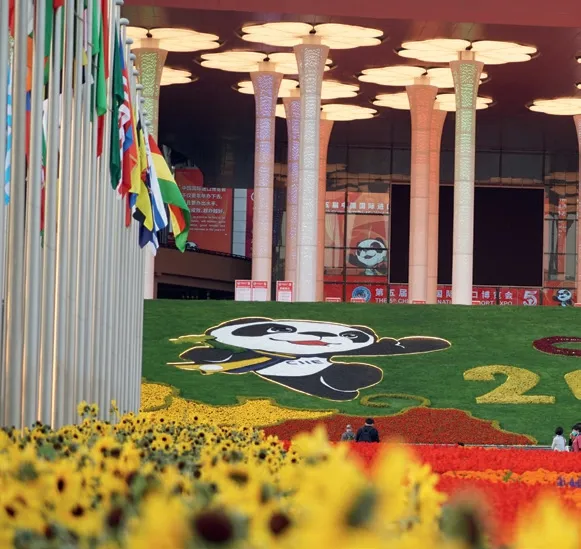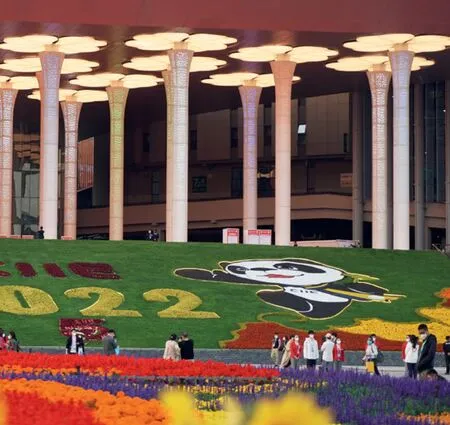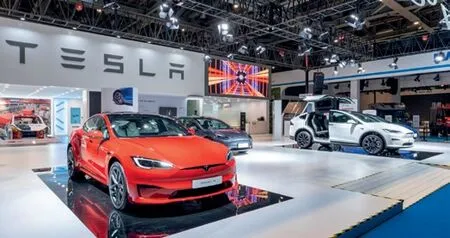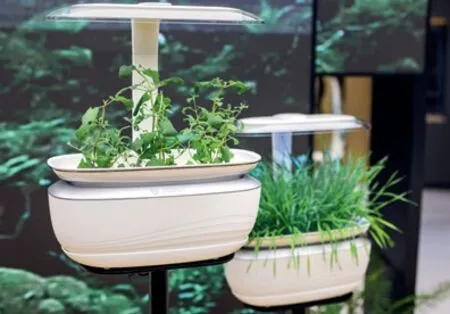A TESTAMENT TO OPENING UP
Annual import expo showcases China’s international mindset By Li Xiaoyang


The National Exhibition and Convention Center, main venue of the Fifth China International Import Expo (CIIE), in Shanghai on November 7
A five-year participant of the China International Import Expo (CIIE), U.S.electric carmaker Tesla wowed visitors at this year’s edition. Its new models Model S Plaid and Model X Plaid,together with the humaniform Optimus Bot, made their debut on the Chinese mainland at the expo, which ran in Shanghai from November 5 to 10. Initiated in 2018, the CIIE is the world’s first national-level import expo. Over the past five years, many participants like Tesla have grown along with the Chinese market.
Breaking ground in 2019, Tesla’s Shanghaibased Gigafactory is the first wholly foreign-owned car manufacturer in China, delivering its vehicles to domestic and overseas consumers. Its second Gigafactory in China is reportedly in the works. The company is also expanding its charging network to bolster market acceptance.
“The report to the 20th Communist Party of China National Congress in October once again stressed the country’s commitment to further opening up. Over the past years,Tesla has participated in and benefited from China’s opening up as it explores the Chinese market and its great demand and cooperates with Chinese enterprises,” Tao Lin,Vice President of Tesla China, toldBeijing Review.
“The CIIE has provided access for international enterprises to enter the Chinese market. For Tesla,China is a key market. We have great confidence in the Chinese market and China’s economic growth,” Adrian Hamczyk, a Tesla engineer, said during an expo briefing.
This year’s CIIE attracted 145 countries, regions and international organizations, including first-time participants like the Republic of Nicaragua. More than 2,800 enterprises from 127 countries and regions participated in the business exhibition,showcasing 438 new products, technologies and services. Participants included 284 industry leaders andFortune500 companies, of which nearly 90 percent had also attended previous editions of the event.
With the Regional Comprehensive Economic Partnership (RCEP), a free trade agreement (FTA) between the 10 Association of Southeast Asian Nations member states and five of their trading partners—China, Japan, the Republic of Korea, Australia and New Zealand, entering into force earlier this year, all of its members were in attendance, marking just how swiftly the world’s largest trading bloc is taking off.
The products and services on display ranged from typical ones like wines and beef to artificial intelligence and virtual reality technologies and robots. Another highlight was the assortment of novelties designed to improve daily life, including smart rice cookers and hi-tech cosmetic gadgets. Booths for the least developed countries once again were free of charge.


Tesla electric cars on display at the Fifth CIIE on November 8
The Fifth CIIE witnessed a total $73.5 billion worth of tentative deals for one-year purchases of goods and services, Sun Chenghai,Deputy Director of the CIIE Bureau, told a press conference following the expo’s conclusion.The figure represented an increase of 3.9 percent from last year’s, he added.
“The CIIE has boosted China’s imports and industrial exchanges,with new technologies and products on display every year since 2018.Over the past three years, China has hosted the expo amid COVID-19-induced challenges, as it aims to widen its opening up and share the benefits with the world,” Nie Pingxiang, a researcher with the Chinese Academy of International Trade and Economic Cooperation under the Ministry of Commerce,toldBeijing Review.
Productive presence
International companies used this year’s CIIE to further explore their presence in the Chinese market,introducing smart, green and userfriendly products and services. Germany-based technology powerhouse Siemens presented robotic surgery systems and smart transport solutions. The company’s open digital business platform Xcelerator,supporting the digital transformation of Chinese enterprises, made its China debut at this year’s expo.
“Siemens expects to work with its Chinese counterparts to boost China’s digital and green development. Through the CIIE, China and the world share a market, co-create industrial prosperity, and achieve a win-win outcome for the future of an open world economy. With this, we have high expectations of the economic outlook for both China and the world,” Xiao Song, President and CEO of Siemens China, toldBeijing Review.
U.S. technology enterprise Honeywell was another global company joining the event for the fifth consecutive year. This time around, it brought along technologies in fields such as carbon capture and renewable fuel. William Yu, President of Honeywell China, toldBeijing Review, “The CIIE is a platform for Honeywell to highlight its new technologies and solutions, debut its flagship innovations, expand its investment in China, and strengthen its partnerships.”During the past four expo editions, Honeywell displayed some 100 innovative technologies, products,and digital ready-now solutions.The CIIE has witnessed the company’s long-term partnerships with Chinese associates.
While participating in China’s smart and green transition, international companies share the benefits arising from the country’s upgrading and expanding market demands.More and more Chinese consumers are willing to pay for a novel and exciting experience. German engineering and technology company Bosch took this year’s CIIE as an opportunity to introduce its smart cooker, indoor gardening device,hydrogen heater and smart driving systems. The products all intend to promote green consumption.
According to Bosch, the smart cooker comes with a myriad of recipes and culinary tips to make cooking at home easier, in turn helping reduce takeout plastic and waste. Equipped with smart watering and light systems, the indoor gardening device, manufactured from recycled materials, allows for flowers and vegetables to grow in just nutrient liquid indoors throughout the year.
“As a long-term investor in China, Bosch has benefited from its sound growth. We will continue to help improve the Chinese consumer’s quality of life, and expand investment in fields including hydrogen and automated driving in the Chinese market,” Bosch China President Chen Yudong toldBeijing Review.
With the rapid evolution of China’s beauty industry, international cosmetic brands have long maintained close ties with this market. French beauty giant L’Oréal presented a headset that monitors users’ brainwaves as they experience different scent families. This allows for accurate sensing and monitoring of preferences, stress and attention to detail, resulting in a perfect scent to match their mood.
Moreover, this year’s CIIE featured a wide range of products and services generated by new consumer demands in recent years, like camping, cycling and indoor exercising. The expo presented related imports from different countries,bringing Chinese consumers closer to the global manufactures.
Online presence
This CIIE took place in the leadup to Double 11, China’s incredibly popular annual online shopping festival happening from late October to November 11, initiated by e-commerce giant Alibaba in 2009. During the expo, global products were presented both on site and online through live-streaming, so consumers could purchase goods from the comfort of their own home. Today, many overseas brands opt to set up shop on Chinese e-commerce platforms to expand their presence in the country’s market.

A smart indoor gardening device presented by German engineering and technology company Bosch at the Fifth CIIE on November 5
On November 5, mobile-only marketplace Pinduoduo and China’s state broadcaster CCTV jointly hosted a live-stream session that introduced hundreds of imports from the expo, attracting over 20 million viewers.
“Chinese consumers are refining their import demands, which in turn promises great prospects for China’s cross-border e-commerce market,” Han Rui,Vice President of e-commerce platform JD.com and head of the company’s international business, told a forum on the sidelines of the expo.
According to Han, more overseas businesses have entered the Chinese market since the RCEP took effect in January given the agreement facilitates market access.
Wider access
The CIIE’s five editions have seen an increasingly open China. From 2018 to 2021, exhibitors launched more than 1,500 new products, technologies and services, with total expected turnover exceeding $270 billion, the Ministry of Commerce said.
Over the past few years, China introduced a slew of measures to further its opening up. From 2017 to 2021,the country increased its number of pilot free trade zones (FTZs) from 11 to 21, and cut items on the FTZ negative list, used to define industries in which foreign companies cannot invest and specify restrictions or bans on certain types of foreign investment, from 95 to 27.In 2021, China’s first negative list for cross-border trade in services was introduced in the Hainan Free Trade Port.
China is the world’s second largest consumer market. Since 2017, it has remained the world’s largest trading nation in goods and the second largest recipient of foreign direct investment globally,according to Nie.
China has become a major trading partner of over 140 countries and regions. It has signed more than 200 documents for cooperation with 149 countries and 32 international organizations under the Belt and Road Initiative, which the country proposed in 2013 to promote connectivity along and beyond the ancient Silk Road routes. FTA partners account for roughly 35 percent of China’s foreign trade, she added.

An employee of French sports goods retailer Decathlon demonstrates how to ride a land surfboard at the Fifth CIIE on November 8
“China’s bid for membership of the Comprehensive and Progressive Agreement for Trans-Pacific Partnership (CPTPP) and the Digital Economy Partnership Agreement (DEPA) demonstrates its resolve to advance regional economic integration,” Nie said.An FTA covering 11 Asia-Pacific economies that took effect in late 2018, the CPTPP is widely considered to have the highest standards for trade rules and market access.The DEPA, a new type of trade partnership agreement, was initiated by New Zealand, Singapore and Chile in June 2020.
Confirmed confidence
Despite external challenges,countless CIIE participants expressed their confidence in the Chinese market. Many companies,including Japan’s electronics company Panasonic,German technology enterprise ZEISS and New Zealand’s dairy brand Theland, have already signed up for the Sixth CIIE.
Maximilian Foerst, President and CEO of ZEISS Greater China, toldBeijing Reviewhow the company’s products had received good response from Chinese consumers. “If you look at the last five years of ZEISS, we have been growing, despite COVID-19, close to 20 percent in the Chinese market every year. This is a clear sign Chinese consumers endorse our products,” Foerst added.
“The stability and resilience of the Chinese market have provided a high-quality business environment. In the coming years, we will continue to expand investment in China and contribute to China’s high-quality development,” Hideki Ozawa,President and CEO of Canon China, a Japan-based camera manufacturer, toldBeijing Review.
Denmark-based LEGO Group has also been stepping up its investment in China over the past decade. It has opened over 380 LEGO brand retail stores in 105 cities nationwide, and since this year has expanded its manufacturing capacity in Zhejiang Province.
A survey released by British multinational investment bank HSBC on November 6 showed that 82 percent of firms surveyed,totaling nearly 3,400, expect their businesses in China to see growth in the next year, and 93 percent plan to up their trade with China with the RCEP unleashing more potential.
To support foreign-funded enterprises in China and broaden the opening up, Nie said it is essential to further shorten the negative lists for foreign investment access and improve related rules, regulations,management and standards.
China also needs to boost and upgrade domestic demand as it opens the market wider, which will in turn drive industrial restructuring at home, she concluded. BR

